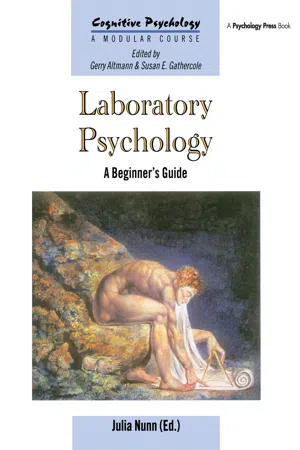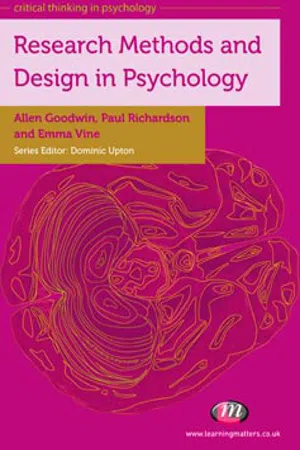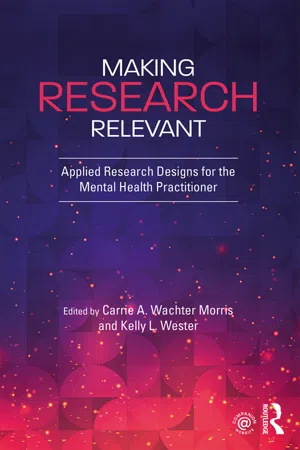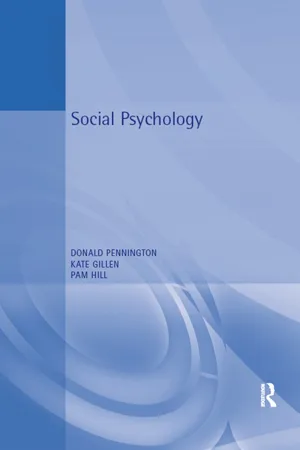Psychology
Correlational Studies
Correlational studies in psychology involve examining the relationship between two or more variables to determine if they are related and to what extent. These studies do not establish causation but provide valuable insights into the connections between different factors. By analyzing the strength and direction of correlations, researchers can gain a better understanding of the patterns and associations within psychological phenomena.
Written by Perlego with AI-assistance
Related key terms
9 Key excerpts on "Correlational Studies"
- eBook - ePub
Laboratory Psychology
A Beginner's Guide
- Julia Nunn(Author)
- 2018(Publication Date)
- Psychology Press(Publisher)
allocate a group of infants to a condition where they were deprived of their mothers. Of course an experimental design permits greater control over the influence of other variables but the advantages of active manipulation of variables carry with them a moral duty to act responsibly.SUMMARYCorrelational Studies allow analysis of behaviour that has been passively observed—rather than collected under experimentally rigorously controlled conditions.- Determining the cause of a correlation between variables requires special care. If two variables A and B are correlated then there are three possible causal interpretations:
- (i) A may be the cause of B;
- (ii) B may be the cause of A;
- (iii) Some other variable may cause A and B.
- Correlational Studies can be used to investigate behaviour occurring outside the laboratory which it might not be ethical or practically possible to observe under laboratory conditions.
Experimental and correlational approaches: A comparison
Whereas the experimenter is interested in the variation he creates by manipulating variables, the correlator is interested in the variation already existing between individuals and/or groups of individuals within or across cultures. The correlator’s aim is to understand the variance produced by nature. For the experimental psychologist individual differences in the subjects of the study are often seen as a problem rather than a focus of interest. A large amount of variation obtained between subjects within a treatment condition is seen as an indication that the experimenter has not controlled the experiment tightly enough. In experimental studies individual variation is termed “error variance” and is one source of variation that the experimenter will deliberately try to eliminate by matching subjects or using homogeneous subject groups. - eBook - ePub
- S Alexander Haslam, Craig McGarty(Authors)
- 2018(Publication Date)
- SAGE Publications Ltd(Publisher)
9 Examining Relationships between Variables: CorrelationKey goals for this chapter
- Introduce correlation – a procedure for examining relationships between variables.
- Introduce Pearson’s r – a statistic that quantifies the nature and strength of the linear relationship between two variables.
- Explain how the results of correlational analysis should be interpreted, with particular reference to the difference between correlation and causation.
A lot of what we have talked about in the previous two chapters relates to comparisons between means, and comparing means is what psychologists typically do when they use experimental methodology. However, in a great deal of research investigators confront another interesting question: What is the relationship between two variables? For example, how is stress related to heart disease? How is socio-economic status related to mental health? How is personality related to the judgements people make?This type of question can be addressed by experiments (as in the previous chapter, where we used an example of the relationship between the amount of physical contact and attraction), but is more typically examined in surveys. In surveys the researchers collect information about variables where there may be many different values for each variable (in the attraction study, for example, lots of different levels of contact, not just two, and lots of different levels of attraction). Surveys also often measure two or more variables, each with multiple levels. We can contrast this with the case of a t-test where we have an independent variable with just two levels (a categorical variable) and a dependent variable with multiple levels.In survey research we often want to know whether two variables vary together. In other words, we want to determine whether there is an association between the variables. This is quite different from the example of the within-subjects t-test, where we are interested in the question of whether there are informative differences between participants’ scores on different measures. In this chapter we want to look at pairs of scores to see whether high scores are consistently associated with high scores (and low scores with low scores) or whether high scores are consistently associated with low scores. Where there is a relationship between variables that takes either of these two forms we say there is a correlation - eBook - ePub
- Paul Richardson, Allen Goodwin, Emma Vine(Authors)
- 2011(Publication Date)
- Learning Matters(Publisher)
- We have specifically pointed out that this correlational design is used exclusively to assess the degree of association between two (or more) variables. It is not looking at differences between scores, and therefore produces no information about the cause-and-effect relationship between these variables. However, it is true to say that without a significant correlation coefficient, then no relationship exists between the variables. What are the implications of this statement?
- Any conclusions that you may draw from a study involving the association between two variables might be at risk due to the influence of other variables. Therefore, researchers will often measure other variables and partial their effects out, i.e. attempt to remove their influence on the other variables. If you conducted such a study, how would you decide which other variables to collect – what would you need to consider in order to select such variables?
- An extremely useful extension of researching the degree of association between variables is the ability to predict future scores. This may be a new concept to you in research methodology, but what do you think are the possible benefits of this approach? Can you foresee any limitations?
Summary: what you have learned
In this chapter, you were introduced to another type of design often used in research – the correlation. However, unlike the experimental designs presented in the preceding chapters, studies that use correlation are not investigating the causal relationship between variables – no variables are being actively manipulated. Instead, this research design helps us to investigate the degree of association between two (or more) variables. People often confuse correlational designs with repeated-measures (within-participant) designs. This is because in both designs participants are tested on the tasks on numerous occasions; however, correlated designs do not require the same tasks to be completed – it is possible to study the association between different tasks or variables!We discussed how the associations between two variables can be visually represented by using a scatterplot. This helps to demonstrate any linear trends in the data. This association can be measured with a correlation coefficient – a figure that lies somewhere between ±1 and 0. This serves two purposes: it shows the direction of the relationship (positive, negative or none) and also the strength of this relationship (weak, medium or strong). - eBook - ePub
Statistics in Social Work
An Introduction to Practical Applications
- Amy Batchelor(Author)
- 2019(Publication Date)
- Columbia University Press(Publisher)
5 THE STATISTICS OF RELATIONSHIPSA nalyzing relationships between variables that affect people is as important as analyzing relationships between people. Correlational methods help you better understand people, communities, and policy. If you are interested in what protective factors might help develop resilience in your client, correlations help with that. If you have ever wondered whether a person’s income can help predict school outcomes for their children, correlations help with that too. Or if you have ever wondered whether older adults who are lonely are more likely to experience poor health outcomes, correlations can provide useful context there too. The relationships between these variables affect the people you work with, and correlations help you analyze variables more effectively.LEARNING OBJECTIVES By the end of this chapter, you should understand the following concepts: • What correlation is (and is not)• How to use the coefficient of determination • How to read scattergrams and correlation tables CORRELATION• How to determine the strength and direction of a correlation based on Pearson’s rCorrelation is the statistical analysis that describes the strength and direction of a relationship between variables. As discussed in chapter 1 , in your practice, you might hope that by increasing the number of counseling sessions a client attends (variable X), you will increase the reported happiness of your client (variable Y). Understanding how one variable is related to another is at the heart of your practice, regardless of the specific context you work in or the population you work with.You must always remember that even strong correlations do not mean one variable caused - eBook - ePub
- Gustav Levine, Stanley Parkinson(Authors)
- 2014(Publication Date)
- Psychology Press(Publisher)
Usually, when both variables are simply observations (measurements or classifications), rather than one being controlled by the experimenter, the direction of causality is not clear. In fact, which variable is the criterion variable and which is the grouping variable is not always clear. That is why the question being answered is often limited to whether the two variables are related. By contrast, when the experimenter controls the status of the subjects on one variable, manipulating one of the variables, the direction of causality can be inferred. For example, suppose one could arrange for some parents to consistently spend much time with their children, and for other parents to spend little time with their children, the assignments to the different time arrangements being random. Of course, this could not be done for ethical reasons, but assume that it had somehow been arranged in an authoritarian state. A difference in depression between the two groups of children could then be interpreted as having been caused by the different amounts of parental attention.Correlational ResearchIt is fairly common, when analyzing the data in an experiment that only includes subject variables, to use the statistical technique of correlation. Although other statistical techniques are also used, and subject variable research is not the only place where correlational techniques are applied, it has nonetheless become commonplace for subject variable research to be called correlational research. When researchers hear the phrase correlational research , they generally make the assumption of limitations on conclusions concerning causality. (Further discussion contrasting correlational research with manipulated variable research is offered in chapter 4 , where different research designs are examined. A discussion of when to use the statistical technique of correlation is offered in chapter 5 , the chapter explicating statistical procedures.)There are some techniques for determining the direction of causality in some subject variable situations, using some advanced statistical techniques. But in most instances with subject variables the knowledge gained from research is limited to whether or not the variables are related and whether it is a positive or negative relationship.A positive relationship is one in which high scores on one variable are associated with high scores on the other variable, with similar correspondences for low scores, and for moderate scores. A negative relationship - Nancy Fenton, Jessica Flitter(Authors)
- 2015(Publication Date)
- Research & Education Association(Publisher)
double blind procedure involves both the experimenter and the participants being unaware of who has received the independent variable. Double blind studies eliminate both experimenter and participant bias.STUDY TIPBe able to identify the participants , variables , and groups within a sample experiment.A researcher investigating the effects of listening to music while studying on test performance randomly assigns high school student participants to a music group or a quiet group while preparing for a test. The researcher subsequently compares the two groups’ test scores using inferential statistics and concludes that p = .05, which indicates the results are statistically significant.• The participants in this study are high school students.• The independent variable in this study is listening to music.• The dependent variable in this study is test performance.• The control group in this study consists of students randomly assigned to the quiet group for studying.• The experimental group in this study consists of students randomly assigned to listen to music while studying.Correlational MethodCorrelational Studies allow researchers to determine whether a relationship exists between two or more variables. Although correlational research cannot determine cause and effect, these studies illustrate the strength and direction of the relationship between variables, allowing for prediction.The data used in the correlational method is collected through other research designs, such as surveys, interviews, and case studies. Even very strong correlations cannot be perceived as cause and effect relationships because it is possible that both variables are in fact caused by an additional factor in what is referred to as the third-variable problem . Variables may be found to be correlated either positively or negatively. A positive (direct) correlation means that, as one variable increases, so does the second variable or, as one variable decreases, so does the other. In a positive correlation, both variables move in the same direction. For instance, the statement that the taller a person is, the larger his or her shoe size will be, indicates a positive correlation. This could also be stated as the shorter a person is, the smaller his or her shoe size will be. A negative (inverse) correlation means that high scores on one variable will be paired with low scores on the other variable. For example, if the data indicates that as age increases, eyesight deteriorates, this would be a negative correlation between age and eyesight. In some cases, two variables are not related to each other at all, resulting in a non-correlation . Sometimes individuals identify an illusory correlation , an incorrect perception that two variables are related or- eBook - ePub
Making Research Relevant
Applied Research Designs for the Mental Health Practitioner
- Carrie A. Wachter Morris, Kelly L. Wester(Authors)
- 2018(Publication Date)
- Routledge(Publisher)
The interpretation of the results is structured based on the strength and direction of the relationship of the correlation. For a positive relationship, as one variable increases, the other variable increases as well. For a negative relationship, as one variable increases, the other variable decreases. The results of a correlational design can only inform researcher about the relationship, but the results do not infer causality of the relationship. In other words, a correlation would not imply that one variable causes another variable but rather would describe the relationship between the two.Figure 7.1 Examples of CorrelationsNote: (a) no correlation, (b) strong positive correlation, (c) strong negative correlationData Analysis: Causal-Comparative Research Design
Descriptive Statistics
Descriptive statistics are used to describe your data. Typically, these statistics include the mean, mode, and median for your groups. For example, when conducting a causal-comparative study, you are testing whether there is a difference in the mean scores of each of your groups. In the case of the present example, you would test whether there is a difference in the mean scores of social support and anxiety between male and female clients. Descriptive statistics do not typically allow you to draw inferences or conclusions based on the mean scores but simply provide you a visual of whether one group is, on average, greater or less than another group.Inferential Statistics
Inferential statistics are used in a causal-comparative research to demonstrate a relation between your independent and dependent variables (Brewer & Kubn, 2012). Unlike descriptive statistics, inferential statistics allow you to make inferences, or conclusions, about your results. There are several types of statistical analyses that may be used when conducting causal-comparative research; however, the three most commonly used statistical tests for causal-comparative research designs include the chi-square test, paired-samples and independent t- - eBook - ePub
- Richard Gross, Rob McIlveen(Authors)
- 2016(Publication Date)
- Routledge(Publisher)
control condition, researchers could simply observe the number who cross when they are not supposed to. In the experimental condition one of the researchers would act as a ‘model’ and cross the light at red. A second researcher would count the number of people who also crossed. If repeated many times, at different traffic lights, with the finding that more were found to cross in the presence of a model, we might conclude the data supported the hypothesis.Field experiments offer the advantage of a real-life setting but have less control over the situation than laboratory experiments. Variables like the weather, number of people in the street, time of day, day of the week, etc., may all influence behaviour and be potential confounding variables. Field experiments are very popular in social psychology, as you will see, but require more careful planning than you might at first think.Using naturally occurring social events as social psychology experiments often requires the researchers to become participant observers. There is a penalty for this: researchers may, inadvertently or otherwise, influence the attitudes and behaviours of those in the group. Another problem is that it is difficult, if not impossible, to predict when an event suitable for social psychological research is going to take place. Often a researcher will only get very short notice and may be unprepared or less well prepared than he or she would like to be. The main advantages are that naturally occurring events provide social situations which could not practically or ethically be conducted in a laboratory or field experiment.1.6.3 Correlational StudiesCorrelational research has two aims: to assess (a) whether two or more variables are related; and (b) the type of relationship existing between the two variables. Consider again our example of prejudiced people having prejudiced friends, this could be investigated using correlational research as follows. To test our theory a questionnaire could be administered, say, to 100 people and the 20 highest scorers selected as our pool of prejudiced people. These 20 people would then be asked to name a friend; the researcher would then administer the same questionnaire to these 20 friends. Support for our theory would be obtained if the 20 friends also scored high on the questionnaire. - eBook - ePub
Companion Encyclopedia of Psychology
Volume One
- Andrew M. Colman(Author)
- 2018(Publication Date)
- Routledge(Publisher)
A research finding is said to be statistically significant if the probability of obtaining such an extreme finding by chance alone is sufficiently small, by convention usually less than 1 in 20 (the 5 per cent significance level, sometimes written p <.05). If a research finding is statistically significant, then the researcher is justified in concluding that the observed effect is "real" and not due merely to chance. If, on the other hand, it is not statistically significant, then chance cannot be ruled out as an explanation and it is impossible to draw any firm conclusion from the result. For a full explanation of this concept, see chapter 12.3 (A. W. MacRae). Correlation Two variables are said to be positively correlated if high scores on one of them tend to go with high scores on the other, and low scores on one with low scores on the other, like people's heights and weights. The usual statistical index of correlation, which is symbolized by r, ranges from 1.00 for perfect positive correlation, through zero for no correlation between unrelated variables, to-1.00 for perfect negative correlation. The heights and weights of adults in Britain are positively correlated. According to a survey of a representative sample of 10,000 men and women, which yielded results very similar to findings reported in the United States, the correlations are in fact.47 for men and.35 for women (Knight, 1984), and both of these correlations are of course statistically significant. For more on correlation, see chapter 12.3 (A. W. MacRae). Cognition Cognition (from the Latin cognoscere, to apprehend) is a rather elastic term used in psychology to refer to attention, thinking, problem-solving, remembering, and other mental processes that can be broadly described as information processing
Learn about this page
Index pages curate the most relevant extracts from our library of academic textbooks. They’ve been created using an in-house natural language model (NLM), each adding context and meaning to key research topics.








